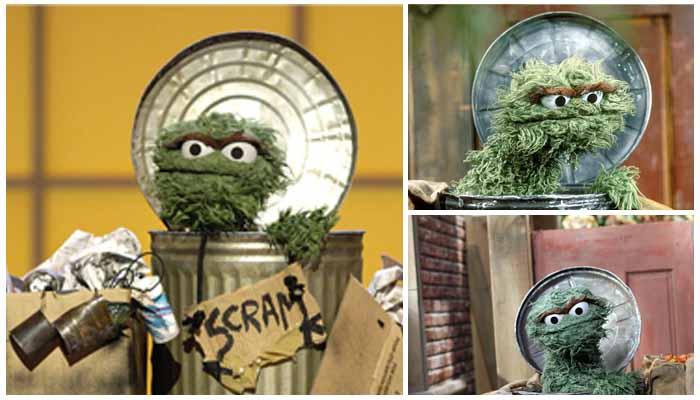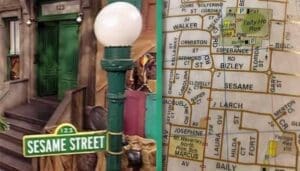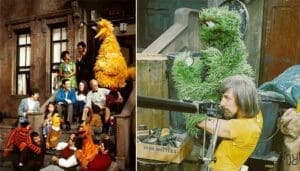For over five decades, the vibrant world of Sesame Street has captivated and educated generations of children. Amidst a cast of sunny and optimistic characters, one figure stands out for his unwavering negativity: Oscar the Grouch. With his signature frown and love for all things unpleasant, Oscar has surprisingly become a beloved icon. His presence begs the question: what is it about this perpetually grumpy Muppet that has allowed him to not only endure but also thrive in the landscape of children’s television?
Oscar the Grouch made his debut in the very first episode of Sesame Street, which aired on November 10, 1969. Initially, this resident of a trash can sported bright orange fur. This initial design choice suggests that the concept of a character who contrasted with the generally cheerful atmosphere of Sesame Street was present from the outset. The change to his now-iconic green hue occurred in the following year, attributed within the show’s lore to a less-than-relaxing vacation in Swamp Mushy Muddy. This narrative detail added a layer of quirky charm to his already distinct persona. Interestingly, early concept drawings envisioned Oscar as a magenta-colored monster with a spiky appearance. This evolution from a spiky magenta creature to an orange and then green furry grouch indicates a process of refinement, likely influenced by the technical capabilities of early color television and a desire to create a visually memorable character. The final green color likely provided a stronger visual contrast against the other Muppets and the vibrant street setting.
The creation of Oscar stemmed from several key motivations. Jim Henson, the visionary behind the Muppets, sought to integrate these characters more fully into the main Sesame Street set, rather than confining them to interstitial segments. The idea of a Muppet residing in a trash can was part of this vision. Furthermore, Henson drew inspiration for Oscar’s name and personality from Oscar Karp, the famously gruff owner of a restaurant called Oscar’s Salt of the Sea, which Henson and head writer Jon Stone frequented. Karp’s unkempt appearance and disagreeable disposition served as a model for the character. Beyond these inspirations, the creators of Sesame Street also intended for Oscar to indirectly represent racial and ethnic diversity. His differing manners and tastes were meant to act as a metaphor for the differences between people, aiming to foster tolerance and understanding in young viewers. While this intention was commendable, some early viewers interpreted Oscar as a negative portrayal of poor, urban populations. This highlights the complexities inherent in using character archetypes to address sensitive social issues in children’s programming. Ultimately, Oscar’s grouchy nature also served to provide an antagonistic element, offering a contrast to the generally cheerful residents of Sesame Street.
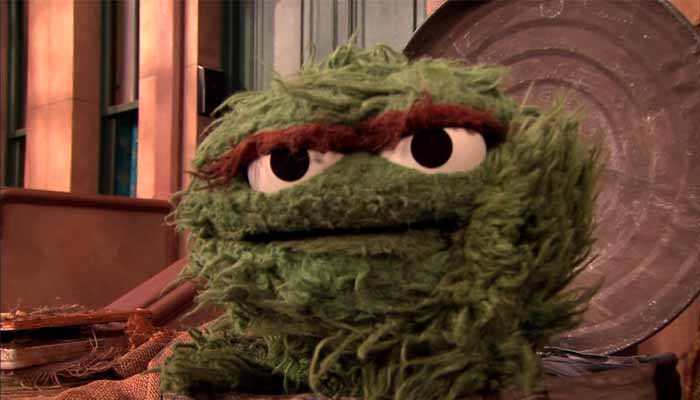
Oscar’s defining characteristic is his unwavering grumpiness. He openly expresses his dislike for anything considered “nice,” such as rainbows, candy, and chocolate. Instead, he revels in loud noises, collecting junk, arguing, and rainy days. His contrarian nature is a constant source of humor, as happiness often makes him sad, and sadness can trigger anger. Despite this outwardly negative persona, Oscar possesses a hidden soft side, particularly evident in his relationships with his pets, including his best friend, Slimey the Worm. This duality – the gruff exterior masking moments of affection – adds depth to his character, making him more than just a one-dimensional curmudgeon. Even his romantic life reflects his disposition, as he has a girlfriend named Grundgetta, who is also a grouch, and their relationship is predictably distant and marked by mutual grumpiness.
Oscar’s home is as iconic as his personality. From the outside, his trash can appears to be of normal size. However, in a delightful twist of Muppet logic, the interior is surprisingly spacious, reportedly containing amenities such as a farm, swimming pool, ice rink, bowling alley, and even a piano. This “bigger on the inside” aspect adds a touch of fantasy to his character, sparking children’s imaginations and perhaps symbolizing the hidden value he finds in discarded objects. The actual trash can puppet used for filming has a hinged lid and a large opening in the back to allow the puppeteer to control Oscar.
Despite his general misanthropy, Oscar has formed some significant, albeit unconventional, relationships with the residents of Sesame Street. One of the most notable is his dynamic with Elmo. Despite Oscar’s constant attempts to rebuff him, Elmo insists that they are good friends. Their interactions often involve Elmo’s cheerful attempts to engage Oscar in positive activities, which are typically met with Oscar’s signature grumpy reactions. This unlikely friendship underscores the show’s themes of acceptance and demonstrates that connections can form even between seemingly opposite personalities.
Oscar’s relationship with Big Bird is another study in contrasts. Big Bird’s boundless kindness and enthusiasm stand in stark opposition to Oscar’s grumpiness. Adding an intriguing layer to this dynamic is the fact that the same puppeteer, Caroll Spinney, brought both characters to life. This could be interpreted as representing the wide spectrum of emotions and personalities that exist within individuals and society. Their interactions range from Oscar’s typical teasing, such as during Christmas, to surprising moments of concern, as seen when Oscar felt guilty and helped search for a missing Big Bird.
Oscar also shares a unique bond with Maria. He has a special nickname for her (“Skinny”) and, despite his usual grumpiness, has shown moments that suggest a deeper, albeit grudging, fondness. This challenges the notion that Oscar dislikes everyone and indicates that even the grumpiest individuals can form special connections. A notable anecdote recounts Maria calling Oscar from the hospital after the birth of her daughter. Finally, Oscar’s closest companion is his pet worm, Slimey. This relationship further highlights Oscar’s capacity for affection, even if it is directed towards a worm, and his appreciation for the unconventional.
Beyond simply entertaining, Oscar the Grouch serves several educational purposes within Sesame Street. He was specifically designed to help children understand the spectrum of human emotions, both positive and negative. Through Oscar, the show normalizes the experience of less pleasant feelings like grumpiness and anger, teaching children that it is okay to feel a range of emotions. In a world that often emphasizes constant happiness, Oscar provides a valuable counterpoint, validating children’s feelings and offering a way to process them. Furthermore, Oscar’s different tastes and manners act as a metaphor for racial and ethnic differences, promoting the important values of acceptance and tolerance. The way the other Sesame Street characters embrace Oscar, despite his negativity, models for young viewers that differences should not be a barrier to belonging and that embracing diversity enriches the community. In later years, Oscar also took on the role of teaching children about recycling and the importance of reusable materials. Even through his characteristic grumbling, Oscar can inadvertently impart valuable lessons, often by providing a contrasting example or by demonstrating that kindness and acceptance can be extended to everyone, regardless of their disposition.
Oscar’s impact extends far beyond the confines of Sesame Street. He has made numerous appearances in movies, including “The Great Muppet Caper” , “A Muppet Family Christmas” , and “Night at the Museum: Battle of the Smithsonian”. “The Adventures of Elmo in Grouchland” provided a more in-depth exploration of his world, including the fabled Grouchland. His grumpy demeanor has also graced various television shows, with cameos in popular series like “The Simpsons” , “Portlandia” , “Scrubs” , “South Park” , and even a “Joker”-inspired sketch on “Saturday Night Live”. He has even ventured into the world of game shows, appearing on “1 vs. 100” and an ABC special on economics.
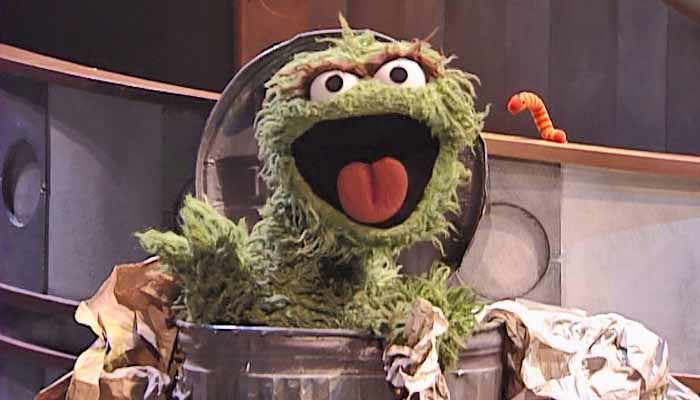
Oscar’s legacy is also documented in literature. Caroll Spinney, his original puppeteer, co-authored “The Wisdom of Big Bird (and the Dark Genius of Oscar the Grouch)”. Other Sesame Street books featuring Oscar include “How to Be a Grouch” and “What’s in Oscar’s Trash Can?”. The sheer volume of Oscar-themed merchandise, ranging from t-shirts to toys and accessories , further attests to his enduring popularity. Beyond entertainment, Oscar has served as the mascot for Waste Reduction Week in Canada and even inspired an Apple Macintosh program. His appointment as Chief Trash Officer for United Airlines’ Sustainable Airline Fuel program in 2023 demonstrates his continued relevance in contemporary culture.
The enduring popularity of Oscar the Grouch can be attributed to several factors. His grumpiness, while seemingly negative, resonates with the everyday frustrations and negative emotions that everyone experiences. In a society that often emphasizes relentless positivity, Oscar provides a refreshing and relatable outlet for acknowledging and even embracing negativity in a lighthearted manner. Furthermore, Oscar’s unwavering commitment to his grouchy nature can be seen as a form of honesty and authenticity. He doesn’t pretend to be happy when he isn’t, which can be surprisingly admirable in a world often filled with superficiality. His presence also provides a crucial balance to the overwhelming optimism of Sesame Street. By showcasing a character who isn’t always cheerful, the show explores a wider range of emotions and perspectives, making it more relatable and nuanced. For many adults, Oscar evokes strong feelings of nostalgia for their childhoods. Crucially, his acceptance by the other Sesame Street residents teaches children about tolerance and understanding, demonstrating that even those who are different or difficult deserve to be part of the community.
However, Oscar’s character has also faced critical scrutiny. Early on, some critics raised concerns that his depiction could perpetuate negative stereotypes of urban minorities. These criticisms highlight the importance of thoughtful representation in children’s media and the potential for unintended interpretations, even when the initial intentions are positive. Others have interpreted Oscar as a metaphor for the outsider, the non-conformist, or even figures within counter-culture movements. This perspective suggests that his appeal might lie in his rejection of mainstream norms and his embrace of individuality, albeit through the lens of grumpiness. There is also the argument that Oscar’s negativity can be educationally valuable by showing children how to navigate interactions with different personalities and emotions. By observing how the other characters interact with Oscar, children can learn empathy and develop strategies for dealing with people who might not always be cheerful.
For many fans, Oscar the Grouch represents more than just a grumpy Muppet. He is a figure they can relate to on their own bad days, someone who embodies the occasional desire to be left alone. They appreciate his honesty and lack of pretense, finding humor in his negativity and recognizing the underlying kindness that occasionally surfaces. For many, he is also a source of nostalgia, a reminder of cherished childhood memories spent watching Sesame Street. The enduring appeal of Oscar suggests that he fills a unique and important niche in children’s media, demonstrating that it is okay to embrace all kinds of personalities, even the rotten ones.
In conclusion, Oscar the Grouch’s legacy is a testament to the power of embracing the full spectrum of human emotions, even the negative ones. From his initial orange hue to his iconic green fur, from his seemingly small trash can to its surprisingly spacious interior, and from his grumpy pronouncements to his occasional acts of kindness, Oscar has carved a unique and enduring place in the history of children’s television. He has taught generations of viewers about emotions, acceptance, and the value of being true to oneself, all while reminding us that sometimes, a little bit of grumpiness can be a wonderfully relatable thing. Now, if you’ll excuse me, I hear a beautiful sunny day happening outside, and that’s just awful. Scram!

